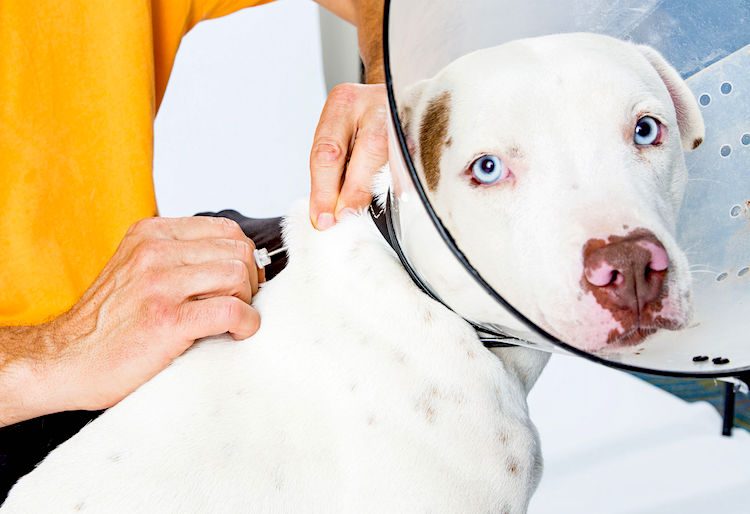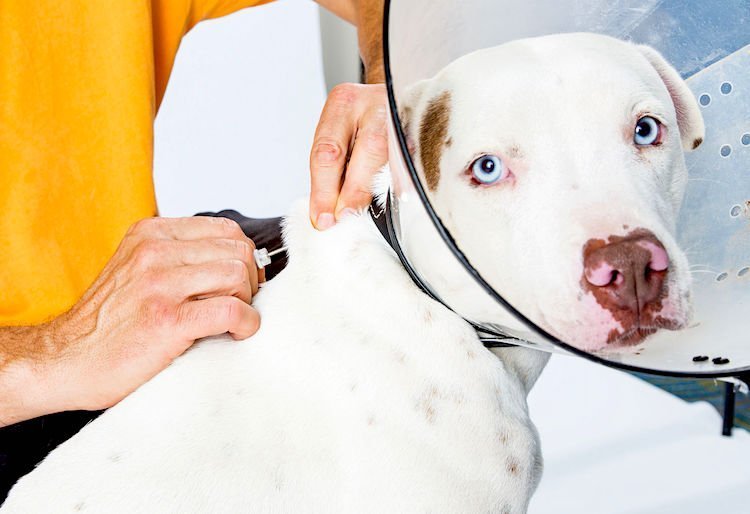This pet health content was written by a team of writers including a veterinarian, Dr. Debora Lichtenberg, VMD. It was reviewed for accuracy by Dr. Pippa Elliott, BVMS, MRCVS, and was last updated June 11, 2024
If you have questions or concerns, call your vet, who is best equipped to ensure the health and well-being of your pet. This article is for informational purposes only and is not a substitute for professional medical advice, diagnosis or treatment. See additional information.

The Emotional Benefits of Microchipping Your Pet
The best thing you can do for a pet who might wander off is microchip them. While all dogs should be microchipped, most veterinarians see more missing cats than dogs and have reunited many with their families. Microchipping is a simple and economical insurance policy.
Anyone who has waited anxiously at home for a lost pet can understand the overwhelming feelings of guilt and sadness. The relief and gratitude of being reunited with a lost pet, thanks to a microchip, are indescribable. That’s the power of a pet microchip.
What Is a Pet Microchip?
A pet microchip is a small electronic device that provides a permanent form of identification for pets.
- Size and Material:
- About the size of a grain of rice.
- Encased in biocompatible glass, ensuring it is safe to be implanted in your pet’s body.
- Unique Identification:
- The microchip contains a unique identification number.
- This number is linked to your contact information in a pet recovery database.
- Database Registration:
- After implantation, it’s essential to register your pet’s microchip with your contact information.
- Keeping this information up to date is crucial for effective identification.
Understanding what a pet microchip is and its role in providing permanent identification helps highlight the importance of microchipping your pet for their safety and your peace of mind.
How Does a Pet Microchip Work?
A pet microchip is a tiny device about the size of a grain of rice. Encased in glass, it’s designed to be implanted in your pet’s body and contains a small computer chip.
- Implantation: The microchip is implanted between your pet’s shoulder blades using a needle.
- Storage: This computer chip stores your contact information.
- Scanning: Most animal shelters and vet offices have scanners that can read pet microchips. They routinely scan any animal found or brought in.
Pet microchips are a reliable way to ensure your pet’s information is always accessible if they go missing.
Does My Pet Need a Microchip?
Any pet can venture too far out due to curiosity, chasing another animal, or being stolen. It only takes a second for this to happen, and soon you’ll be scrambling to drive the streets, call neighbors, and post flyers.
- Traditional Methods: While these methods can help recover a lost pet, they have limitations. If the person who finds your dog or cat hasn’t seen your flyer, they might take the animal to the nearest shelter or vet’s office, hoping you can be found.
- Collar Issues: Collars can slip off or be removed, leaving no way of identifying the pet as yours.
- Microchip Advantage: If the pet had a microchip that could be scanned, the vet or shelter will find you much faster.
According to the American Veterinary Medical Association (AVMA), “Microchips are great for permanent identification that is tamper-proof, but nothing replaces a collar with up-to-date identification tags when it comes to quickly identifying a found pet.”
Will a Microchip Hurt My Pet?
The process of installing the microchip is similar to your dog or cat getting a shot. Here are some details to provide more context:
- Procedure: The needle used for microchipping is slightly larger than those used for typical injections, but the pain is minimal, and the process is usually quick.
- Anesthesia: Anesthesia is not required for microchipping, making it a straightforward procedure that can be done during a regular visit to your vet’s office.
- Recovery: Pets typically do not experience any significant discomfort or recovery time after the implantation. You may notice a small bump at the injection site, but this usually subsides quickly.
Overall, microchipping is a simple and safe procedure that offers peace of mind and increased chances of reuniting with your pet if they ever get lost.
Check out this quick video about how pet microchips work, then we’ll discuss microchip benefits:
Benefits of Microchipping Your Dog or Cat
Microchipping offers numerous benefits that make it an essential step for pet owners. Here are some key advantages:
- Ease of Procedure:
- Fast and easy implant done with a needle in your vet’s office.
- No anesthesia needed.
- Minimal pain, similar to a shot.
- Enhanced Pet Recovery:
- Helps locate families of lost pets, avoiding your lost pet getting adopted or euthanized.
- Peace of mind and closure, as animals that are found, even if deceased, are scanned for a microchip so their families can be notified.
- Cost and Longevity:
- Affordable cost: $25–$55.
- Most implants last around 25 years and usually won’t need to be replaced or updated.
- Scanning and Identification:
- Professionals with scanners are trained to scan the entire body in case the microchip has migrated elsewhere. This is uncommon, and the chip usually doesn’t migrate far from the shoulder area, but they check all over to be sure.
- Universally used as a method of identification in multiple countries, which can be a benefit to those who travel with their pets.
- Natural Disaster Preparedness:
- Natural disasters, such as hurricanes or tornadoes, can cause many animals to be lost unexpectedly. Having a microchip can help rescue professionals find you faster instead of placing your dog in a shelter or foster care.
By microchipping your pet, you ensure a higher chance of being reunited if they ever get lost, providing both security and peace of mind.
What Pet Microchips Don’t Do
While pet microchips offer significant benefits, it’s important to understand their limitations:
- No Tracking Capability: Microchips are not tracking devices. There is no GPS or locator within a microchip, so they cannot track your pet’s location in real time.
- Dependency on Scanners: Microchips are useful only if scanned. If your pet is lost and found, the person or facility must have a scanner to read the microchip and access your contact information.
- Limited Scanner Availability: Not all places have scanners or universal scanners. Some older
- Not a Replacement for Tags: According to the American Veterinary Medical Association, while microchips provide permanent identification, they should not replace collars with up-to-date identification tags. Tags are a quick and visible way to identify a pet and contact its owner immediately.
Understanding these limitations can help you take additional steps to ensure your pet’s safety and quick return if they ever get lost.

Addressing Concerns About Pet Microchipping
Do Pet Microchips Cause Cancer?
There is a persistent myth that microchips cause cancer in dogs and cats. This notion is often propagated by proponents of natural and holistic animal health care who share sensational stories about the risks of microchipping.
- Safety of Microchips: We would like to set the record straight: microchips are safe.
- Evidence: As of June 2017, there was evidence of only 2 tumors at the site of a microchip out of the millions of pets microchipped in the United States, and just 2 tumors in 3.7 million pets in the United Kingdom over a 13-year span.
- Risk Assessment: All in all, the risk of a pet microchip causing tumors at the site of implantation is very, very small.
It’s important to understand that the benefits of microchipping far outweigh this minimal risk, ensuring your pet’s safety and increasing the likelihood of being reunited if they ever get lost.
Where the Cancer Myth Began
The myth that microchips cause cancer began in the early 2000s with several studies involving laboratory mice and rats.
- Study Findings: These studies found that microchips caused foreign body-induced tumors in less than 1% of the rodents.
- Context of Studies: The mice and rats used were already part of cancer studies, meaning they were not a random, genetically varied population.
- Researcher Caution: Researchers cautioned against using these findings as evidence that microchips cause tumors in dogs, cats, or humans. Despite this, the information was sensationalized.
In 2007, ABC News reported on these studies because Alzheimer’s patients were beginning to be microchipped.
- FDA’s Position: Based on the rodent studies, the U.S. Food and Drug Administration suggested that more research was needed before claiming microchips are completely benign in humans.
- Sensationalism: ABC added a quote from a cancer researcher who said he would not put a microchip in his pet, further sensationalizing the story.
This led to widespread misinformation and fear, despite the lack of evidence supporting the claims for pets.

Microchips: A Great Safety Record
It has been more than a decade since the laboratory animal studies and ABC news coverage that sparked concerns about microchips.
- Extensive Use: In those years, millions more cats and dogs have been microchipped with very little reason for concern.
- AVMA’s Opinion: In 2013, the AVMA published its opinion on microchips, stating they are safe. They documented only 2 cases of skin tumors related to microchips: 1 in a dog and 1 in a cat. The AVMA emphasized that “Mice and rats are more susceptible than other species to developing foreign body-induced tumors; therefore, extrapolation of increased incidences of foreign body-induced tumors in mice to increased risk in other species, including humans, is inappropriate.”
- Expert Opinion: Dr. Andy Roark, DVM, estimates the chances of a pet microchip causing cancer are around 1 in 1.85 million. He describes the risk as “incredibly tiny,” but notes that “it’s that extremely small window of uncertainty that people propagating sensationalistic click-bait online exploit.”
Dr. Roark highlights the harm caused by sensational stories, saying, “I’ve seen the terror-inducing headlines and the harm [these sensational stories] do to pets that end up lost without a microchip because of them. ‘Pet owners duped!’ ‘MICROCHIPS CAUSE CANCER!’ etc.” These headlines deter people from taking a step that could very well save their pet’s life.
Risks vs. Benefits of a Pet Microchip
No, pet microchips are not 100% safe. However, evidence shows that tumors caused by microchips are an extremely rare occurrence.
- Rare Occurrence: Tumors caused by microchips are very uncommon.
- Importance in Recovery: The benefits of microchips in recovering lost pets far outweigh the minimal risks. Vets have likely reunited multiple lost pets with their humans thanks to microchips.
- Peace of Mind: Unless you have an insurance policy guaranteeing your pet will never run out of an open door, jump a fence, or wander beyond safe territory, a microchip is a wise choice.
If your pet is precious to you, the tiny 12 mm microchip is worth its weight in gold, offering significant peace of mind and a higher chance of reuniting with your pet if they ever get lost.

Additional Considerations for Pet Microchipping
Do-It-Yourself Microchipping?
We don’t recommend using home kits for microchip implantation. Here’s why:
- Effectiveness and Safety: The contents of home kits can be ineffective, and you might have trouble implanting the device yourself, making the process difficult for you and painful for your pet.
- Professional Assurance:
- A vet will scan the microchip after implementation to ensure it works, which is a significant advantage.
- If something goes wrong, you’ll always know whom to turn to for assistance.
- Cost Consideration: Most home kits cost about the same as having a professional perform the implantation, so you won’t save any money.
Allowing a vet to implant the chip ensures the process is done correctly and safely, providing peace of mind and professional support if needed.
What Else You Can Do
While the benefits of getting your dog or cat microchipped certainly outweigh the shortcomings, there are other steps you can take to help ensure your pet is returned to you if lost:
- Collar and Tag:
- Always ensure your pet has a collar and tag.
- Metal tags work better than plastic tags as they don’t chip or break, the information doesn’t wear off as easily, and they usually last longer.
- Prevent Roaming: Don’t allow your pet to roam freely.
- Responsible Care: Use responsible boarders or sitters if your pet can’t be with you.
- Verify Information: If you microchip your pet, ask to see and verify your contact information that is entered into the computer or written down to send to the microchip company.
- Keep Records: Maintain a copy of this paperwork with your vaccination records and current photos of your pet for easy retrieval.
By taking these additional steps, you can further increase the likelihood of being reunited with your pet if they ever get lost.
Final Thoughts on Pet Microchips
If a tragic end has come to your pet and you find out about it, you might feel inconsolable and sad with all those desperate emotions. But at least you know what happened, providing some closure.
When you’re faced with a missing pet, the unknown factor can be the most nightmarish of all. There’s no closure, and at 4 a.m., you keep wondering if you hear them outside, becoming despondent all over again.
- Peace of Mind: Microchipping offers that extra help if your pets go missing, giving you a better chance of finding them.
- Not a Perfect Solution: It’s not an end-all-be-all solution, but the possibility of a happy ending, even once in a while, makes it worth it.
Please get your pets microchipped to increase the chances of a joyful reunion if they ever get lost.



